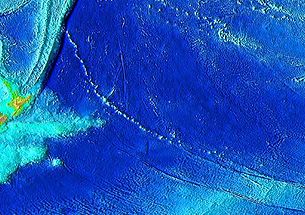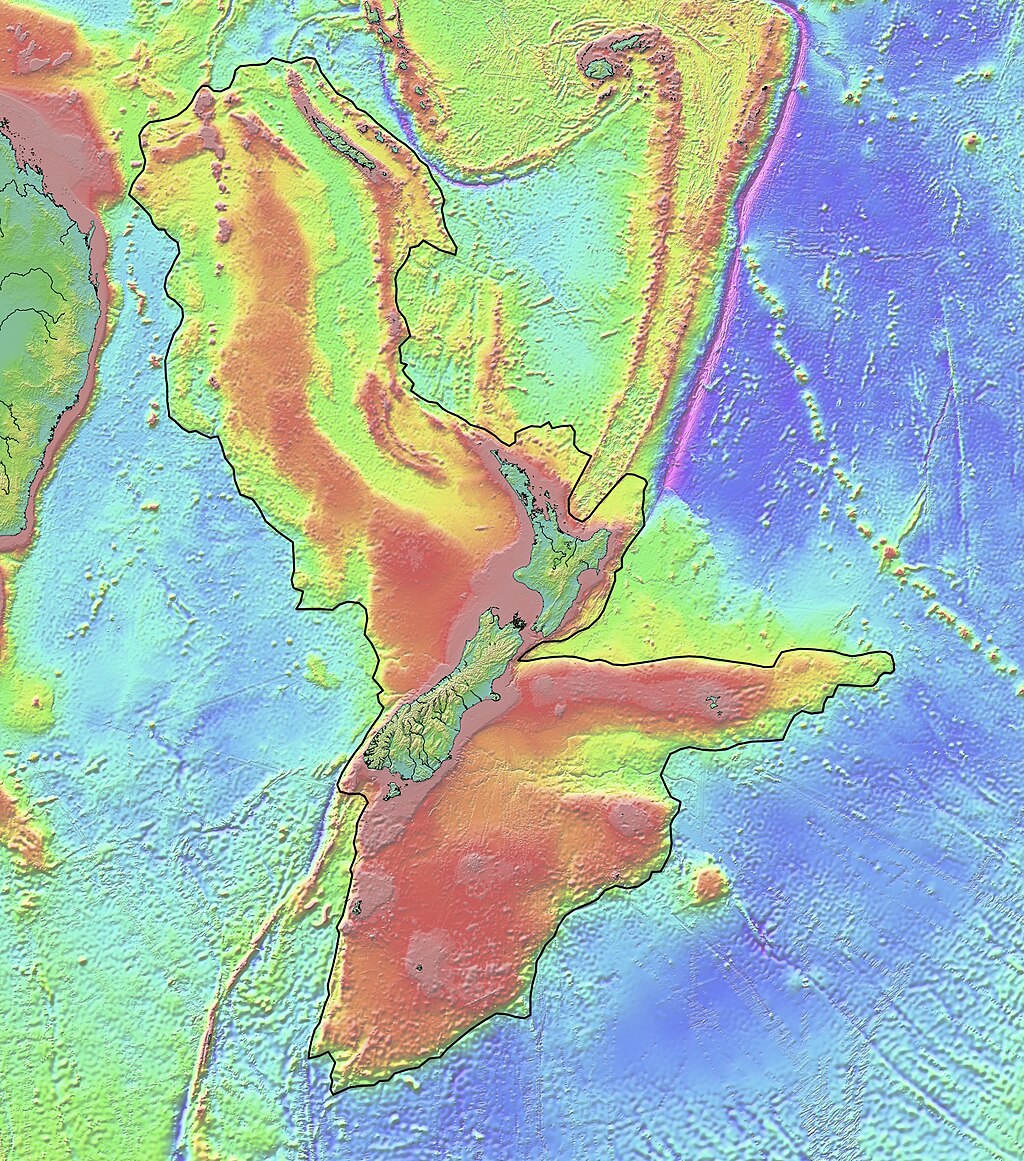| Louisville Ridge | |
|---|---|
 The Louisville Ridge stretches diagonally across this bathymetric map of the southwest Pacific Ocean. The Louisville Ridge stretches diagonally across this bathymetric map of the southwest Pacific Ocean. | |
| Summit area | length:4,300 km (2,700 mi) |
| Location | |
| Location | Southwest Pacific Ocean |
| Coordinates | 38°16′S 167°55′W / 38.27°S 167.92°W / -38.27; -167.92 |
| Geology | |
| Type | Seamount chain |
| Volcanic arc/chain | Louisville hotspot |
| History | |
| Discovery date | 1972 (1964) |
The Louisville Ridge, often now referred to as the Louisville Seamount Chain, is an underwater chain of over 70 seamounts located in the Southwest portion of the Pacific Ocean. As one of the longest seamount chains on Earth it stretches some 4,300 km (2,700 mi) from the Pacific-Antarctic Ridge northwest to the Tonga-Kermadec Trench, where it subducts under the Indo-Australian Plate as part of the Pacific Plate. The chains formation is best explained by movement of the Pacific Plate over the Louisville hotspot although others had suggested by leakage of magma from the shallow mantle up through the Eltanin fracture zone, which it follows closely for some of its course.
Depth-sounding data first revealed existence consistent with a seamount chain in 1972 although some of the seamounts had been assigned as a ridge in 1964 linked to the Eltanin fracture zone system, hence the name.
Geology
 Louisville
LouisvilleSeamounts Wishbone
scarp West
Wishbone
scarp East
Wish-
bone
scarp West
Wishbone
scarp Tonga Trench Osbourn Trough Kermadec
Trench Hikurangi
Plateau Chatham Rise
 Immediate geological relationships of the chain of the Louisville seamounts. The violet line is the very deep trenches of the Kermadec-Tonga subduction zone with its arc volcanoes to the top left. Blue represents ocean depths of a kilometer or so and brown shades are shallower. The black line delineates the East Chatham Rise part of Zealandia continental crust.
Immediate geological relationships of the chain of the Louisville seamounts. The violet line is the very deep trenches of the Kermadec-Tonga subduction zone with its arc volcanoes to the top left. Blue represents ocean depths of a kilometer or so and brown shades are shallower. The black line delineates the East Chatham Rise part of Zealandia continental crust.
The oldest volcanic rocks of the chain come from Osbourn Seamount at 78.8 ± 1.3 Ma and ages become younger in a non linear fashion towards the south east with a youngest age of 1.1 Ma.
Composition studies of the erupted dominantly alkali basalt are consistent with a single Louisville mantle source distinct from other hotspots and the composition has remained homogeneous over at least the last 70 million years. In the past 25 million years magma upwelling rates may have decreased. There is almost certainly a deep plume origin to the hotspot.
The Louisville hotspot chain passes through the western and eastern branches of the Wishbone scarp and while the seamounts show no compositional change as they cross the scarps, the East Wishbone scarp crossing point is associated with a distinct decrease in the volume of the younger seamount eruptives from that point east into the Pacific Plate.
Tectonics
Volcanic hotspot chains are used to suggest the net movements of tectonic plates and so in the case of the large Pacific Plate validation of models of its movement and indeed the hot spot hypothesis itself relies on data from several hot spot chains. As well as the Louisville hotspot there is data over tens of millions of years available from the movements of the Hawaii hotspot and the Arago hotspot. While the model of Pacific Plate movement, including bends in the hotspot track can be made to fit very well there has been long debate on timing of such bends as mismatchs of a few million years appeared to exist.
Subduction
The area of subduction of the Louisville chain into the Tonga Trench is associated with a relative seismic gap beneath the Tonga forearc. This implies that the subduction of the volcanoes compared to normal sediment has a significant impact in terms of normal relief of stress but it is unclear if the subducted volcanoes relieve it as suggested by some or say increase potential for sudden release. Further a postulated historic change in trend of the subducted Louisville chain compared to present is backed up by compositional analysis of more recent arc volcanism as the volcanics from the Louisville chain are recycled. A bathymetric high c. 2 km (1.2 mi) north-west of the Osbourn Seamount has been interpreted as the currently subducting portion of the Louisville chain, but this continuation is not aligned with the existent chain.
Ecology
Some of the seamounts are known coral reef stoney habitats, with typical species including the coral Solenosmilia variabilis, brisingid starfishes (Order Brisingida), and sea-lilies and feather stars (Class Crinoidea). They can be a fishery resource for species such as the orange roughy (Hoplostethus atlanticus) that can be fished by bottom trawling.
Seamounts
The Louisville Ridge includes the following:
See also
References
- ^
Sandwell, David T.; Walter H.F. Smith (1997). "Exploring the ocean basins with satellite altimeter data". Satellite Geodesy. La Jolla: Scripps Institution of Oceanography. Retrieved 2010-01-19.
The Louisville Ridge was first detected in 1972 using depth soundings collected along random ship crossings of the South Pacific. Six years later the full extent of this chain was revealed by a radar altimeter aboard the Seasat (NASA) spacecraft.
- ^ Vanderkluysen, L; Mahoney, J J; Koppers, A A; Beier, C; Regelous, M; Gee, J S; Lonsdale, P F (2014). "Louisville Seamount Chain: Petrogenetic processes and geochemical evolution of the mantle source". Geochemistry, Geophysics, Geosystems. 15 (6): 2380–400. Bibcode:2014GGG....15.2380V. doi:10.1002/2014GC005288. S2CID 128524309.
- "Marine Gazetteer Placedetails". Retrieved 2017-02-20.
- Vanderkluysen, L.; Mahoney, J. J.; Koppers, A. A.; and Lonsdale, P. F. (2007). Geochemical Evolution of the Louisville Seamount Chain, American Geophysical Union, Fall Meeting 2007, abstract #V42B-06.
- Koppers, Anthony A. P.; Yamazaki, Toshitsugu; Geldmacher, Jörg; Gee, Jeffrey S.; Pressling, Nicola; Koppers, Anthony A. P.; Yamazaki, Toshitsugu; Geldmacher, Jörg; Gee, Jeffrey S.; Pressling, Nicola; Hoshi, Hiroyuki (December 2012). "Limited latitudinal mantle plume motion for the Louisville hotspot". Nature Geoscience. 5 (12): 911–917. Bibcode:2012NatGe...5..911K. doi:10.1038/ngeo1638. ISSN 1752-0908.
- Smith, A. G. (2007). "A plate model for Jurassic to recent intraplate volcanism in the Pacific Ocean basin". In Plates, Plumes, and Planetary Processes, Edited by G.R. Foulger and D.M. Jurdy, Geological Society of America Special Paper 530, Boulder, CO. 430: 471–496.
- ^ Koppers, Anthony A. P.; Gowen, Molly D.; Colwell, Lauren E.; Gee, Jeffrey S.; Lonsdale, Peter F.; Mahoney, John J.; Duncan, Robert A. (December 2011). "New 40Ar/39Ar age progression for the Louisville hot spot trail and implications for inter-hot spot motion". Geochemistry, Geophysics, Geosystems. 12 (12): n/a. Bibcode:2011GGG....12.AM02K. doi:10.1029/2011gc003804. ISSN 1525-2027. S2CID 55376246.
- ^ Koppers, A A P; Yamazaki, T; Geldmacher, J; Gee, J S; Pressling, N; Hoshi, H; Anderson, L; Beier, C; Buchs, D M; Chen, L; Cohen, B E; Deschamps, F; Dorais, M J; Ebuna, D; Ehmann, S; Fitton, J G; Fulton, P M; Ganbat, E; Hamelin, C; Hanyu, T; Kalnins, L; Kell, J; Machida, S; Mahoney, J J; Moriya, K; Nichols, A R L; Rausch, S; Sano, S; Sylvan, J B; Williams, R (2012). "Limited latitudinal mantle plume motion for the Louisville hotspot". Nature Geoscience. 5 (12): 911–7. Bibcode:2012NatGe...5..911K. doi:10.1038/ngeo1638.
- ^ Heaton, D. E.; Koppers, A. A. P. (2019). "High-Resolution 40Ar/39Ar Geochronology of the Louisville Seamounts IODP Expedition 330 Drill Sites: Implications for the Duration of Hot Spot-related Volcanism and Age Progressions". Geochemistry, Geophysics, Geosystems. 20 (8): 4073–4102. Bibcode:2019GGG....20.4073H. doi:10.1029/2018GC007759. S2CID 198407241.
- ^ Hanyu, Takeshi (2014). "Deep plume origin of the Louisville hotspot: Noble gas evidence". Geochemistry, Geophysics, Geosystems. 15 (3): 565–576. Bibcode:2014GGG....15..565H. doi:10.1002/2013GC005085. S2CID 128495990.
- Gaastra, Kevin Mitchell; Gordon, Richard G.; Woodworth, Daniel (2022). "Quantification of Pacific Plate Hotspot Tracks Since 80 Ma and the relative Timing of Eocene Plate Tectonic Events" (PDF). Tectonics. Bibcode:2022Tecto..4106772G. doi:10.1029/2021TC006772. S2CID 233890295.
- Timm et al. 2013, Figure 5
- Stratford, W.; Peirce, C.; Paulatto, M.; Funnell, M.; Watts, A. B.; Grevemeyer, I.; Bassett, D. (2015). "Seismic velocity structure and deformation due to the collision of the Louisville Ridge with the Tonga-Kermadec Trench" (PDF). Geophysical Journal International. 200 (3): 1503–1522. doi:10.1093/gji/ggu475. Retrieved 21 May 2023.
- Timm et al. 2013, Discussion and Figure 5
- Timm et al. 2013, Location of the Louisville seamount chain beneath the arc, Discussion & Fig. 5
- ^ Rowden, A A; Anderson, O F; Georgian, S E; Bowden, D A; Clark, M R; Pallentin, A; Miller, A (2017). "High-resolution habitat suitability models for the conservation and management of vulnerable marine ecosystems on the Louisville Seamount Chain, South Pacific Ocean". Frontiers in Marine Science. 4: 335. doi:10.3389/fmars.2017.00335.
- Marine Gazetteer Placedetails:Burton Seamounts
- "40Ar/39Ar Age Determination 11C2724 (KOP000020 - Canopus Guyot, Site U1372)". Retrieved 2023-05-27.
- Marine Gazetteer Placedetails:Currituck Seamount
- Marine Gazetteer Placedetails:Danseur Seamount
- Marine Gazetteer Placedetails:Darvin Guyot
- Marine Gazetteer Placedetails:Osbourn Seamount
- Marine Gazetteer Placedetails:Pierson Seamount
- "40Ar/39Ar Age Determination 11C2815 (KOP000024 - Rigil Guyot, Site U1374))". Retrieved 2023-05-27.
- Marine Gazetteer Placedetails:Rumyantsev Seamount
- Marine Gazetteer Placedetails:Seafox Seamount
- Marine Gazetteer Placedetails:Trobriant Seamount
- Marine Gazetteer Placedetails:Vostok Seamount
- Sources
- Timm, C.; Bassett, D.; Graham, I. J.; Leybourne, M. I.; De Ronde, C. E.; Woodhead, J.; Layton-Matthews, D.; Watts, A. B. (2013). "Louisville seamount subduction and its implication on mantle flow beneath the central Tonga–Kermadec arc" (PDF). Nature Communications. 4: 1720. Bibcode:2013NatCo...4.1720T. doi:10.1038/ncomms2702. PMID 23591887. Retrieved 19 March 2017.
External links
- Expedition 330 - Louisville Seamount Trail, Integrated Ocean Drilling Program, 13 December 2010 to 11 February 2011
- The Louisville Ridge – Tonga Trench collision: Implications for subduction zone dynamics, RV Sonne Research Expedition SO215 Cruise Report, 25 April 2011 to 11 June 2011